We headed west from Havana towards the main tobacco growing region of Cuba. We had to take the Viazul tourist bus because its not possible to get cheaper tickets on second class buses
as there is a ‘no tourist’ policy in place and travelling about the country is hard enough for Cubans so they keep all the tourists on the more expensive buses to ensure there are enough seats for locals to travel. The
tourists in Cuba are different to standard backpackers in Central America, there are virtually no Americans, lots of Canadians, Norwegians and Germans, with a few Russians thrown in, and, in general, an older crowd, so it
was nice to mix with different nationalities for a change.
The soviet built highway we drove along was in good condition but was pretty empty, we only passed by a few old lorries, cars and other buses and at every
junction there would be, alongside a socialist slogan or two, lots of Cubans waiting on the side of the road to be picked up by a lorry or waiting for a hitchhikers car to go past. It’s a moral obligation in Cuba for certain
cars to take hitchhikers, especially ones with blue or orange number plates.
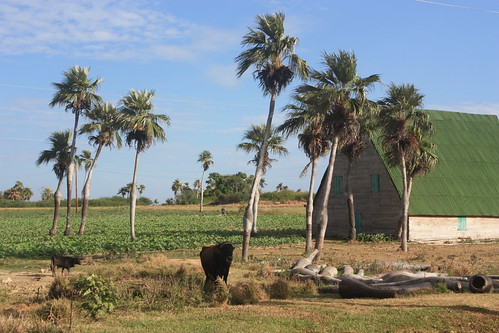
When we arrived in Viñales there was a hoard of casa owners waiting for their guests to arrive and our casa in Havana had prearranged
another casa for us so we didn’t have to worry about searching for somewhere to stay. Our Mum from the new casa had a sign with our names on it Rayan y Yobanna! Isabelita was absolutely lovely and instantly made us feel
at home in her 1950’s built and styled bungalow complete with rocking chairs on the porch. All the casa particulares offer breakfast and dinner for guests so you can eat good quality food freshly prepared. To eat in the casa is the
same cost as a restaurant meal, but it’s better value and home cooked, rather than some of the restaurants that can feel very institutional. Our food experience in Havana was hit and miss, so we thought we would try the home cooking for a change. We weren’t disappointed as Isabela’s dinners were huge as she laid out a spread of pork, congri
(mix of rice and black beans), salad, chips, crisps, and fruit salad, with all plates being refilled before we could say no!
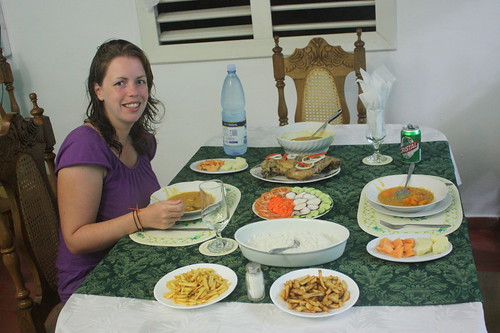
The area
around Viñales is full of karst hills called mogotes and as this is prime tobacco country, the fields are dotted with tobacco farms and farmers inviting you into their homes to show you how they make cigars. It was really
interesting to be shown the process of tobacco from a local farmer and, of course, it helps them to make a few extra dollars on the side when they sell Ryan cigars to give him his first taste of real home grown Cuban cigaros.
He wasn’t disappointed with their suave taste that comes from the way they are freshly made without any chemicals or additives, so they are very organic, apparently!


To explore the region we hired bikes for the day, although my bike had dodgy brakes so I ended up walking down all the hills to stop myself
having an accident. We cycled up to a hotel that was ordered to be built by Castro because of the great view it has of all the karsts.
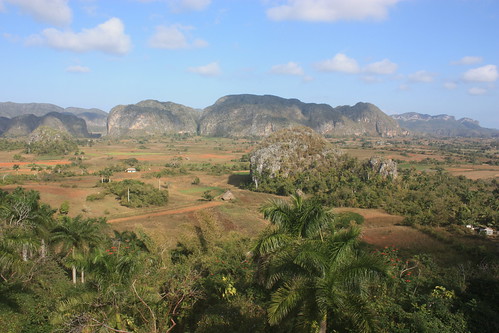
Some of the local attractions were
slightly dodgy, including a prehistoric themed mural that’s meant to show evolution, which was painted in the 1960’s on the side of a karst. We thought it was a bit weird and really not necessary in this beautiful countryside.
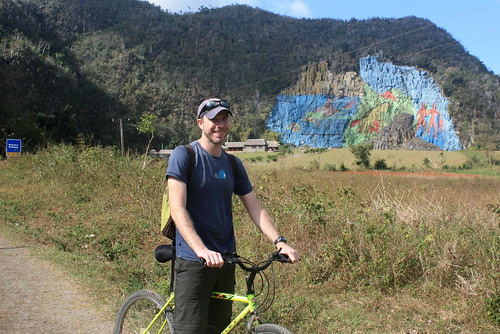
Overall
Viñales had great scenery, friendly locals with straw hats and cigars hanging out of their mouths and a great little plaza in town that was perfect for a post-cycle beer or two.
Cienfuegos
When we arrived in Cienfuegos, 8 hours east of Vinales via Havana, we were met by our next casa, which again had been prearranged for us. We were taken to a lovely colonial home with huge
rooms and a courtyard, where we stayed with Miriam and Gladys, two old school teacher sisters. Again, we were treated really well and fed too much. We have noticed that all the casas seem to have a textbook way of welcoming
guests. They all tell you what the area has to offer and how they can help you arrange any tours or transport, they also all have plastic flower arrangements and photos of family on display and a living room area that is never
used, as if it’s just there to show that the houses are nice and homely in Cuba, just how they want foreigners to perceive them to be. We were always asked the same questions about ourselves, what we do, what we think of
Cuba, as if they were reciting from a list of recommended questions. It reminded us again that even though everyone is extremely friendly and kind, they are only doing this as a way to make money after the heavy taxes imposed on them.
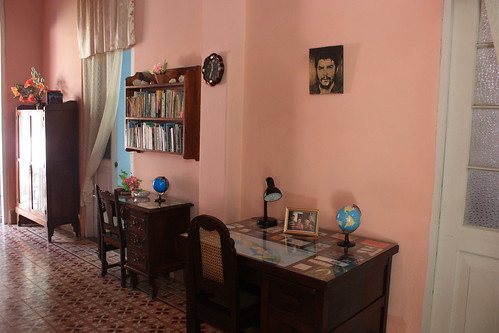
Cienfuegos is a sleepy town with all the historical buildings surrounding the main plaza, so it was easy to see all the sights in a short time.
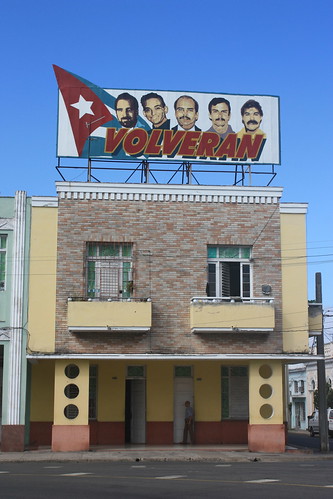
The town’s highlight is the 3km malecon on the Punta Gorda stretch of land that sits alongside the Bay of Cienfuegos. It’s the perfect place for a long walk, people
watching and enjoying the sunset with a cigar, if you are called Ryan!

Cienfuegos is only 15km from the coast so we thought we might as well enjoy one of the beaches this Caribbean island is so famous for even if we would have to brave the
harsh Cuban winter for a beach day. Luckily the winter is still at least 25 degrees and the sea was perfect if we ignored the fish that liked to nibble the dead skin off our feet. We learned the lesson of not ordering
anything for lunch that says it comes with ham as it will only turn out to be spam again!
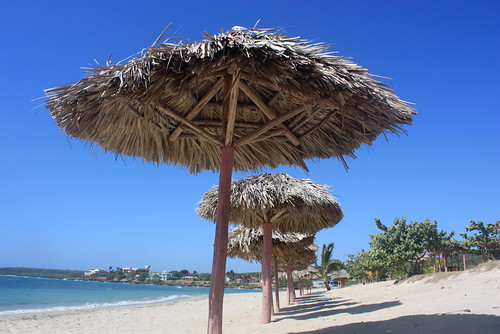
We took an illegal taxi back to town, one that is not licensed so they don’t pay tax and if they are caught they are heavily fined, but the driver offered to take us
back and it was fun for us to ride in a 1970’s Lada, even if we did nearly fall through the worn out seats and could see the road through holes in the floor. It had no working speedo or fuel gauge but got us from a-z just
fine. It’s funny how long these old cars can last if there are no rules, regulations or annual checks saying how safe they should be.
Trinidad
Just an hour away by bus, Trinidad is the prettiest and most colonial city in Cuba and along with that comes the tourists and the hoards of jinateros (hustlers) who follow you around offering
cigars, taxis, restaurants, etc.
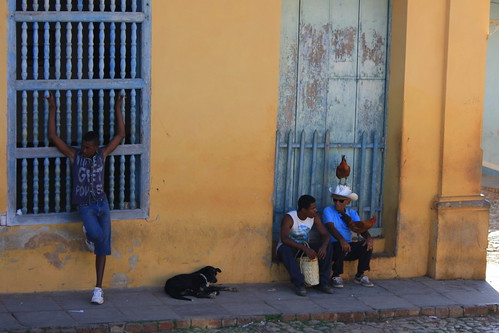
It is very pretty and the views from the museum bell tower at sunset were worth the climb.

We then climbed a hill to a run down church to watch the sunset. There were lots of locals here asking our nationality
so they could exchange CUCs for any foreign coins they had from our country. We were used to this so we lied and told the begging ladies that we were from Bulgaria, so eventually they gave up and sat down and chatted with us in between
bugging other tourists. Of course they knew all about Bulgaria, if you are going to lie to them, don’t pick an old socialist country they know all about!

The next day we headed
out to explore more of the town but this only lasted about thirty minutes before we realised the scorching heat and lack of air conditioning meant we would wither before the morning was complete. So we escaped to the local
beach at Playa Ancon, which was beautiful and the sea was very still, cool and refreshing. Playa Ancon was long so there was plenty of room to find shade under a palm tree or sneak onto a resort sun lounger
without paying, along with picking up a pet to keep us company.

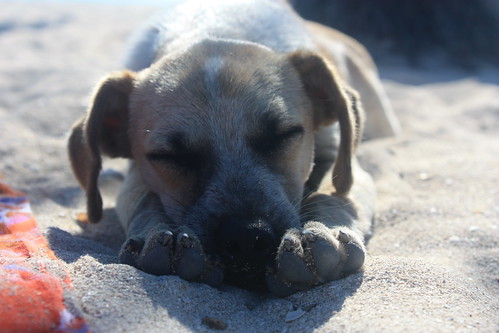
Unfortunately, Trinidad just kept annoying us with continuous hassle on the street and even though we were staying in a lovely
casa with our own roof terrace, our casa momma couldn’t leave us alone and insisted we stay longer in her house even though we told her numerous times we only wanted to stay two nights. You also have to check your change whenever you buy anything as they will always short change you and in one supermarket we were obviously overcharged as the final bill did not add up anywhere near the prices on the shelves, but when we asked for a receipt they refused to give us one, even though there was a big sign over the cashiers head telling customers to request their receipt! There is too much competition here
that it is turning the Cubans into mini capitalists and thieves. We needed to get out of this town and go somewhere quieter so we headed to...
Sancti Spiritus
This town was described to us as the complete opposite of Trinidad so we couldn’t wait to get
there but it turned out to be too true, there was nothing much to see or do and everything in our guidebook took less than an hour to see and nothing was worthy of a photo, so we spent our day in the El Rapido 24 hour cafe
that of course is not 24 hours only maybe 4 hours a day.
Santa Clara
This is the home of the final battles of the revolution that secured Fidel his victory. It was here that Che commandeered a troop of soldiers who derailed an armoured train carrying
over 400 soldiers and ammunition and was the final act that made their opposition, Batista, surrender. The box car trains are on display and are now an interesting museum. The Santa Clara Libre Hotel in the centre
of town still bares the pock marks from bullets that were shot by Che, or, as our lovely casa owner Auturo would say, ”It’s a very famous hotel you know, bang bang bang Che, bang bang bang Che”!

The city is also the final resting place for Che himself as his remains were buried here in 1997 after being recovered from Bolivia. The museum, mausoleum and monument all in his honour on
the outskirts of the town are a fitting status for this hero of socialism and we loved being bossed about by the stewardesses who made us queue up in a very particluar spot before entering and then would follow you around
the museum making sure you looked at everything in the right order!
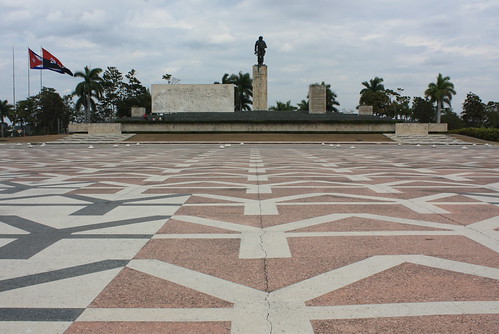
Santa Clara turned out to be the first time we could spend national pesos on two beers, whoo hoo, seems that
the Santa Clarans are too honest and not as CUC hungry as the Havaneros. I think Santa Clara seemed to be a really authentic Cuban city, mainly because it didn’t have really pretty buildings, no beaches nearby and not a
great deal in the way of tourist attractions, so it was definitely worth a visit to escape the crowds and hustlers.
Playas del Este
We then had a few days left before we needed to return to the airport so we headed to the Playas del Este region just 17km east of Havana. This 5km stretch of beach is the
cheaper option for having a beach break without staying in a resort. We stayed at the far end of the beach in the town of Guanabo in a nice casa up on a hill above town, so we had sea views. The weather was slightly against
us and we didn’t have the warmth to laze on the beach all day, but it was a perfect place to unwind, stroll around and let Cuba settle into our heads and really analyse what we thought of the country.

Cuba summary
Cuba is a country that makes you think. It’s a country that offers its people free health care, free education up to university level, free child care for all working parents,
encouragement of sporting achievements, free or heavily subsidised cultural events, free concerts every week in most towns and it only costs $1 to go to the theatre for Cubans or $0.04 to watch the baseball. Cuba’s a beautiful
Caribbean island with free housing, so no mortgage or rent worries, free food rations every month, a place where people share with one another if they have more than their friends and family have. A country where there is
no advertising or marketing anywhere, just a bit of propaganda to read. A place where there is virtually no crime and no guns because if you steal from someone you are really just stealing from yourself. It’s a country where
every car stops to let you cross the road so there is no danger of being run over.
Wouldn’t we all like to live in a country with these pluses? Your answer would probably be yes if you’re happy to pay 80% of your wages as taxes and never have the ability
to be an entrepreneur or better your living standards. Probably yes if you’re happy to wave your right to vote democratically and have freedom of speech against the government and probably yes if you are willing to have
the amount of food you can buy dramatically cut when there are food shortages and if you don’t want good quality food. Cuba made me feel like there is nothing wrong with socialism/communism except that at the end of the
day it doesn’t really work because you can never get a whole country to think and act the exact same way. Cuba is slowly opening up to capitalism and private business licences are being offered although with high taxes. Cubans
want to have all the benefits that their relatives living abroad have and you can understand why because the grass is always greener on the other side. But I can’t help thinking that maybe they will regret longing for capitalism
when the country is full of fast food joints taking over local restaurants, when advertising takes over every spare space and persuades them to spend their new found wealth on products they really don’t need, when
crime increases because the difference between the haves and have nots becomes to great to resist resorting to crime.
Cuba is cigar smoke, jazz music, cadillacs, murals, socialist slogans, old fashions, crumbling
buildings, white beaches, blue sea, poor people, it has so much to offer that we haven’t found in any other country we’ve visited, in all Cuba is an experience, even if you can't work out if you agree with it or not!

Highlights
Favourite Place - Vinales (Jo) Havana (Ryan) Playa Ancon (Both)
Favourite Attraction - Biking around Vinales (Jo) Che Memorial(Ryan)
Favourite Food - Isabel’s dinner (Jo) Congri - rice & beans (Ryan)
Favourite Beer - Mayabe (Ryan)
Favourtie Drink - Papaya juice (Jo)

For those of you thinking of possibly travelling
to the region: Costs in USD
Accommodation - $25 for a room in a casa particular
Restaurant meal - $4-7
Casa Particular breakfast and dinner - $4/$8
330ml Bottled Beer - $1.50
500ml Soft Drink
- $0.75
1.5l Bottle of water - $1
Bus - $4 /hour
Jo y Ryan
Photos: http://www.flickr.com/photos/dojo77/